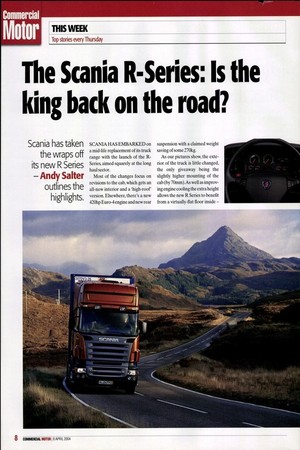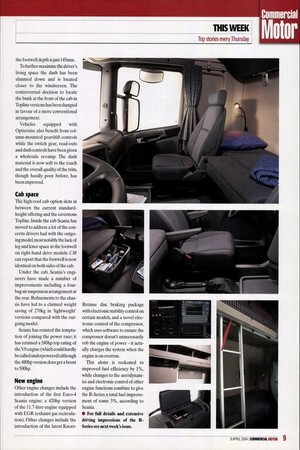The Scania R-Series: Is the king back on the road?
Page 8

Page 9

If you've noticed an error in this article please click here to report it so we can fix it.
Scania has taken the wraps off its new R Series —Andy Salter outlines the highlights.
SCANIA HAS EMBARKED on a mid-life replacement of its truck range with the launch of the RSeries, aimed squarely at the long haul sector. Most of the changes focus on revisions to the cab, which gets an all-new interior and a 'high-roof version. Elsewhere, there's a new 420hp Euro-4 engine and new rear
suspension with a claimed weight saving of some 270kg. As our pictures show, the exterior of the truck is little changed, the only giveaway being the slightly higher mounting of the cab (by 70mm).As well as improving engine cooling the extra height allows the new R Series to benefit from a virtually-flat floor inside —
the footwell depth is just 145mm.
To further maximise the driver's living space the dash has been slimmed down and is located closer to the windscreen. The controversial decision to locate the bunk at the front of the cab in Topline versions has been dumped in favour of a more conventional arrangement.
Vehicles equipped with Opticruise also benefit from column-mounted gearshift controls while the switch gear, read-outs and dash controls have been given a wholesale revamp. The dash material is now soft to the touch and the overall quality of the trim, though hardly poor before, has been improved. Cab space
The high-roof cab option slots in between the current standardheight offering and the cavernous Topline. Inside the cab Scania has moved to address a lot of the concerns drivers had with the outgoing model, most notably the lack of leg and knee space in the footwell on right-hand drive models. CM can report that the footwell is now identical on both sides of the cab.
Under the cab, Scania's engineers have made a number of improvements including a fourbag air suspension arrangement at the rear. Refinements to the chassis have led to a claimed weight saving of 270kg in 'lightweight' versions compared with the outgoing model.
Scania has resisted the temptation of joining the power race; it has retained a 580hp top rating of the V8 engine (which could hardly be called underpowered) although the 480hp version does get a boost to 500hp. New engine Other engine changes include the introduction of the first Euro-4 Scania engine: a 420hp version of the 11.7-litre engine equipped with EGR (exhaust gas recirculation). Other changes include the introduction of the latest Knorr
Bremse disc braking package with electronic stability control on certain models, and a novel electronic control of the compressor, which uses software to ensure the compressor doesn't unnecessarily rob the engine of power — it actually charges the system when the engine is on overrun.
This alone is reckoned to improved fuel efficiency by 1%, while changes to the aerodynamics and electronic control of other engine functions combine to give the R-Series a total fuel improvement of some 3%, according to Scania.
• For full details and extensive driving impressions of the RSeries see next week's issue.






































































































